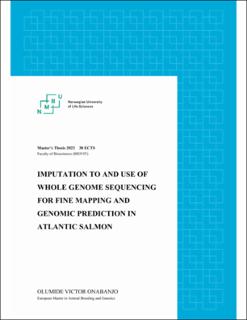| dc.description.abstract | Sea lice (Lepeophtheirus salmonis) infestation of Atlantic salmon (Salmo salar) is a significant challenge facing the Aquaculture industry. This parasite is known to be resistant to chemical control. Previous research that studied the genomic architecture of host resistance to sea lice using low and medium-density SNP panels did not identify any genome-wide significant QTL associated with the trait. Thus, it became imperative to study the genomic architecture of this trait using whole-genome sequencing (WGS) data. However, it is not cost-efficient to resequence thousands of individuals, hence genotype imputation. Therefore, this study aimed to estimate the imputation accuracy (with and without pedigree), perform imputation to WGS for target individuals, estimate heritabilities, perform association tests, and genomic prediction.
A 10-fold cross-validation method was adopted to estimate imputation accuracy (with and without the inclusion of pedigree information) of the reference individuals using FImpute3 software. After imputation accuracy was estimated, genotype imputation of the target population (3185 individuals of the 2017 year class) to whole genome sequencing was carried out without including pedigree information. The imputed genotype and array data of the target population were then used to estimate heritability, perform association tests and estimate the accuracies of genomic prediction for host resistance to sea lice.
The weighted average imputation accuracy (r) without pedigree was estimated to be ~0.85, while ~0.84 was estimated with pedigree. The heritability of host resistance to sea lice was estimated to be 0.21 and 0.22, based upon array and imputed data, respectively. The association test using array and imputed data did not identify any marker associated with sea lice resistance QTL at the genome-wide level. In contrast, one marker on chromosome 7 of the array data surpassed the chromosome-wide Bonferroni corrected threshold and thus was declared significant at the chromosome-wide level. Lastly, a 5-fold within-family cross-validation design was used to assess the accuracy of genomic prediction. The accuracy was estimated to be ~0.65 and ~0.64 for array and imputed data, respectively.
In conclusion, genotype imputation is a valuable tool that saves sequencing costs, and including pedigree information did not significantly improve the genotype imputation accuracy. The trait of interest is moderately heritable and polygenic. The genomic predictions using medium-density SNP genotyping array was equally good or better than using whole genome imputed data. | |
